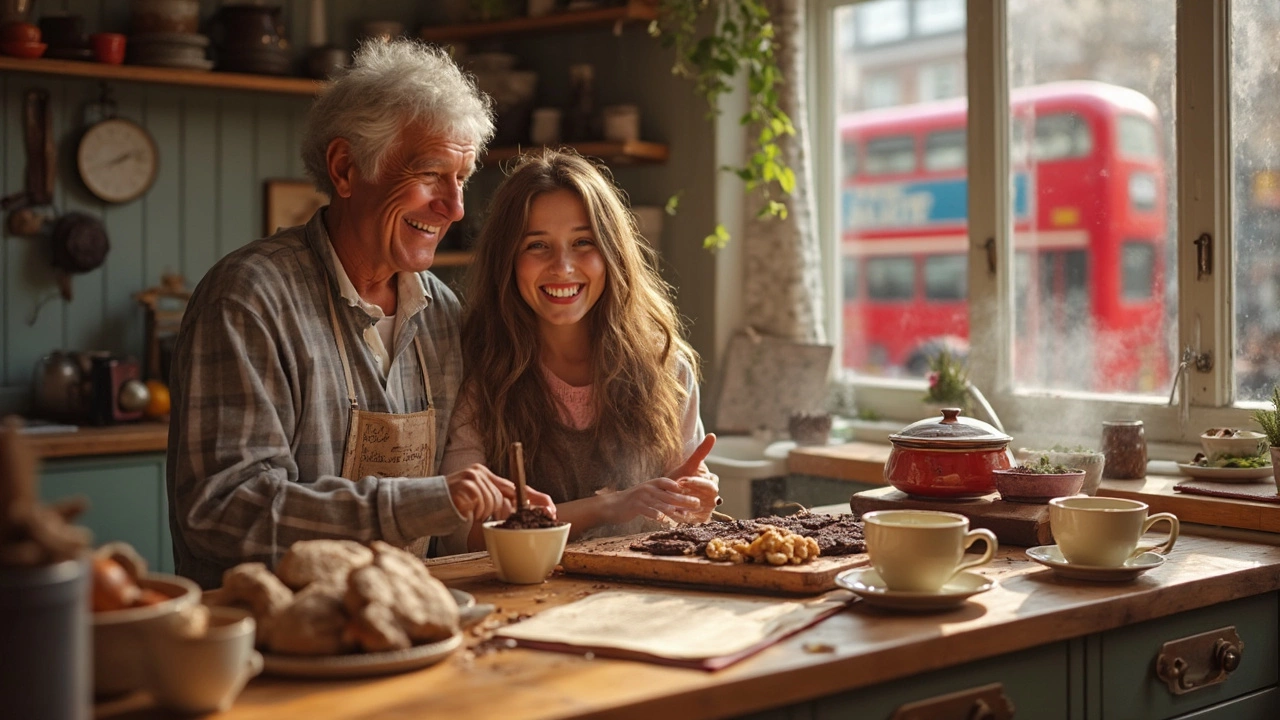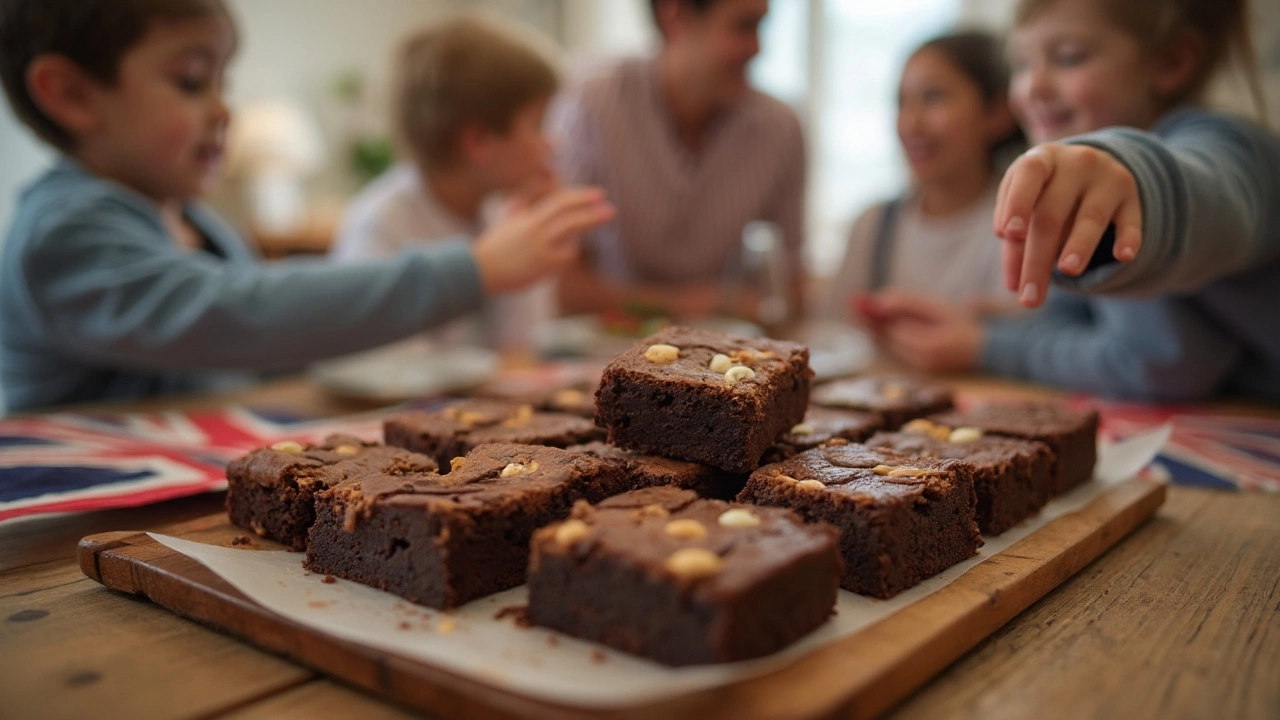
If you ask ten people to describe the perfect brownie, you'll get ten different answers. Some want ooey-gooey centers, while others chase that papery crust or all the chewy edges. Either way, nailing brownies starts with understanding what actually goes in them and why. There’s no such thing as “just throw it all together” in good baking—getting it right makes the difference between a sad, crumbly flop and something people beg you to bring again.
Let’s keep things real. You only need a few basic pantry staples: flour, sugar, eggs, butter (or oil), and, of course, chocolate. But don’t just toss them in a bowl blindly and hope for the best. The type of chocolate you use decides if your brownies taste rich and deep or only kind of chocolate-y. Go for unsweetened cocoa powder if you want control over the sweetness—or toss in a bar of dark chocolate for big flavor. Swapping butter for oil gives a fudgier bite. And yes, a pinch of salt might sound weird for dessert, but it wakes up the flavors like you wouldn’t believe.
If you want to avoid brownies that taste bland or bake up dry, pay attention to the little things: sift your dry ingredients, don’t overmix, and line your pan so nothing sticks. Even the order you mix things can matter. You’d be surprised how just melting the butter instead of creaming it changes the whole texture.
- Breaking Down the Key Ingredients
- Popular Mix-ins and Add-Ons
- Common Mistakes Home Bakers Make
- Simple Hacks for Better Brownies
Breaking Down the Key Ingredients
Getting brownie ingredients right is half the battle. The real deal is using the right stuff in the right amounts. Here’s what matters most:
- Chocolate: This is what sets brownies apart from any old cake. Cocoa powder gives intense flavor and makes things a bit chewier, while melted chocolate adds richness and a thicker texture. For the best batch, use at least 60% cocoa dark chocolate if you want deep flavor.
- Butter or Oil: Butter means richer flavor and a more classic brownie. Oil—especially something neutral like canola—keeps things extra moist and helps get that super fudgy center.
- Sugar: White sugar is the classic, giving you those crackly tops everyone loves. Brown sugar brings in some chew and a light caramel vibe. Some people mix both for balance.
- Eggs: These hold everything together and affect how dense your brownies turn out. More eggs = cake-like. Fewer eggs or using just yolks = denser, richer results.
- Flour: You want just enough flour—too much, and you’ll get cake. Most recipes use about 1 cup per 8x8 pan. Less flour makes for fudgier bars.
- Salt and Vanilla: Salt makes the chocolate pop, and a splash of real vanilla gives even packaged cocoa a flavor boost. Don’t skip either, even if you’re tempted.
Here’s a quick look at what each ingredient brings to the table, literally:
| Ingredient | Main Job | What Happens if You Skip/Change It |
|---|---|---|
| Chocolate (cocoa or bars) | Flavor, density, richness | Brownies taste more like bland cake |
| Butter or Oil | Moisture, mouthfeel, richness | Dry, crumbly brownies |
| Sugar | Sweetness, texture | No shine or crackly top, less flavor |
| Eggs | Binding, structure | Falling apart or weirdly dense |
| Flour | Bulk, texture | Soupy mess or super dry |
| Salt/Vanilla | Flavor enhancement | Dull, flat taste |
Good news? You can experiment. Got only oil? Use it. Want a deep chocolate taste? Mix cocoa powder and melted chocolate. Whatever combo you try, remember: less flour and more fat usually means fudgier brownies, while more eggs and a bit more flour bring you closer to cake territory. It’s all about making the brownies that you crave.
Popular Mix-ins and Add-Ons
This is where brownies really get interesting. Some people never mess with the basic recipe, but the truth is, adding a few extra goodies can totally step up your brownie game. Think nuts, candies, swirls, and more. The trick is making sure your add-ons play nice with the batter and don’t throw off the bake.
By far, the most popular mix-in is chopped walnuts. These add a classic crunch and are basically a brownie staple in the U.S.—in fact, the International Nut & Dried Fruit Council found that almost 35% of American brownie recipes call for walnuts. If you’re into chewy and crunchy, try pecans or almonds. For a gooier experience, stir in chocolate chunks or chips right before baking. If you want to get fancy, swirl in a bit of peanut butter, caramel, or cream cheese—use a toothpick to run through the mix for that bakery-style marbled look.
- Chopped nuts (walnuts, pecans, almonds)
- Chocolate chips or chunks (milk, dark, or white)
- Swirls: peanut butter, Nutella, caramel, or cream cheese
- Candies: mini marshmallows, M&Ms, toffee pieces
- Dried fruit: cherries, cranberries, or apricots
- Oreos, pretzels, or other sweet/salty bites
Don’t overdo it. Try to keep add-ins under 1.5 cups total for a regular 9x13 pan—any more, and brownies might not cook through or could fall apart. Here’s a quick cheat sheet to help you prep the popular ones:
| Mix-in | Prep Tip |
|---|---|
| Walnuts/Pecans | Chop and toast for best flavor |
| Chocolate Chips | Toss lightly in flour to prevent sinking |
| Cream Cheese | Soften and swirl in gently |
| Dried Fruit | Soak briefly in hot water for juicier bites |
| Caramel/Nutella | Drop in spoonfuls and marble for best look |
Trying something new? Add your mix-ins right at the end, just before pouring the batter into the pan. This helps keep the texture even, and you won’t overwork the mix. If you’re after a big crowd-pleaser, pair up chocolate chips with a swirl—people go wild for that combo every single time.

Common Mistakes Home Bakers Make
You'd be surprised how many things can go wrong when whipping up a batch of brownies, even with just a handful of ingredients. Most problems come from tiny missteps that don’t seem like a big deal—until you pull out a pan of hard-edged, dry disappointments.
Burning or underbaking is a classic mistake. Brownies can look done on the top way before they’re cooked inside. Instead of relying on color, poke a toothpick in the center. If it comes out with a few moist crumbs but not gooey batter, you’re golden. Overbaking chases away all the fudginess, so set a timer and check early.
Measuring ingredients wrong throws off the whole balance. Some folks scoop flour straight from the bag, packing it in and making brownies dense. Fluff up your flour, then spoon and level it for accuracy—seriously, it helps every time. Chocolate is another trip-up. Using the wrong kind (like chocolate chips meant for cookies) instead of a good-quality bar or baking cocoa can leave your brownies flat in flavor.
- Mixing too much: Overmix and you end up with tough brownies. Mix just until things are blended.
- Ignoring pan size: That "close enough" attitude? Not great. Using a pan that's too big or small changes the thickness and cook time.
- Skipping the liner: Ever scraped brownies out with a spoon? Not fun. Parchment paper lets them pop out in one clean lift.
- Forgetting salt: Even in sweets, a bit of salt makes chocolate taste brighter. If you leave it out, your brownies can fall flat.
It’s also common to let brownies sit in the pan for too long once baked. They keep cooking in that hot pan and can dry out. Move them to a rack after about 15 minutes.
The truth is, even seasoned bakers slip up with brownies because it’s easy to underestimate how the little things add up. Fixing these habits makes a huge difference, and pretty soon, you’ll get those dreamy, fudgy squares every single time.
Simple Hacks for Better Brownies
Pulling off killer brownies doesn’t need chef-level skills, but it helps to know a few tricks that really make a difference. First, ditch the cheap cocoa—good brownies start with good chocolate. Research from the Fine Cacao and Chocolate Institute found that 85% of taste testers preferred brownies made with real chocolate over cocoa powder alone. If you use both, you get a combo of deep flavor and that signature glossy top.
Let’s talk baking time. It’s super easy to end up with dry, cakey squares if you leave them in the oven too long. For fudgy centers, set your timer for the lowest time in the recipe and do the toothpick test a little before. Look for a few moist crumbs—don’t wait until the toothpick comes out clean or you’ll lose that gooey texture.
Sometimes, the simplest swap makes all the difference. If you want chewier edges, use all brown sugar or half brown, half white. Brown sugar’s extra moisture packs more chew per bite. For a crackly top, whisk your eggs and sugar together for a good 3-4 minutes before adding anything else, just like in this expert tip:
"Beating the sugar and eggs longer helps create that shiny, crackly crust everyone loves on brownies." — Stella Parks, pastry chef and baking author
Once you’re ready to bake, line your pan with parchment so you can lift the whole slab out in one easy go. That way, no more digging pieces out with a spatula and ruining the edges.
| Hack | Effect |
|---|---|
| Beat eggs & sugar for 3+ minutes | Shiny, crackly crust |
| Use brown sugar | More chew in each brownie |
| Mix in real chocolate | Deeper flavor, fudgy texture |
| Test with toothpick early | Keeps centers gooey |
| Line pan with parchment | Easy release, sharp edges |
If you want to step it up, try to chill the brownies for a few hours after baking. It sounds weird, but this trick makes cutting so much cleaner and the flavor richer. If you’re really after show-stopping brownies, finish with a sprinkle of sea salt straight out of the oven—it’s a game changer for bringing out that chocolate flavor.
- Invest in an oven thermometer—most home ovens run hot or cold and guessing isn’t worth it.
- Don’t slice brownies hot. Let them cool (at least a little!) for way neater squares.
- Try adding espresso powder if you want next-level chocolate intensity. Just one teaspoon is enough.